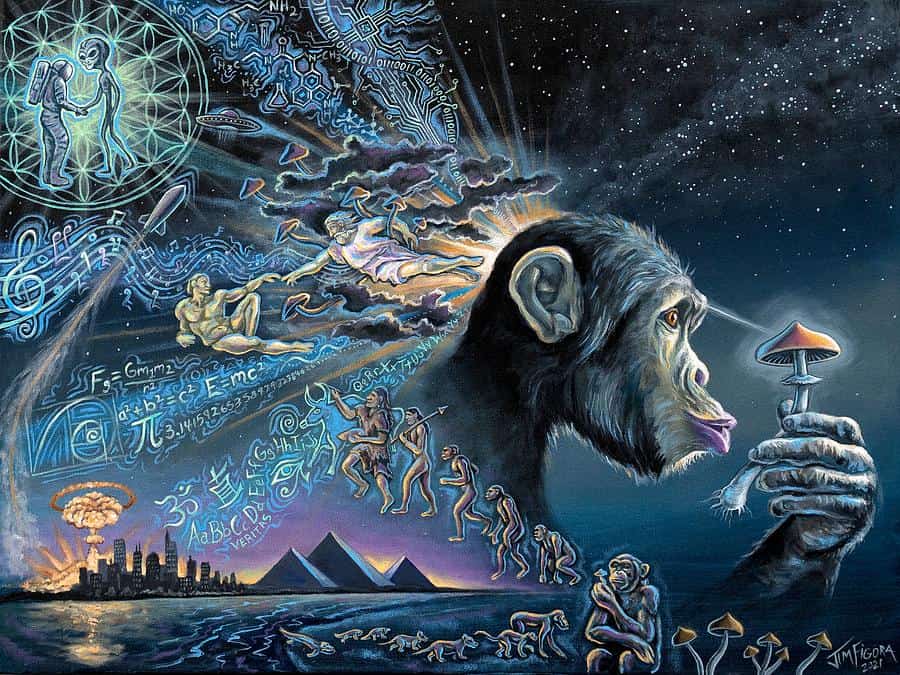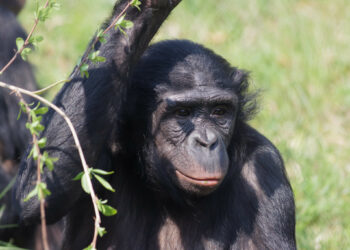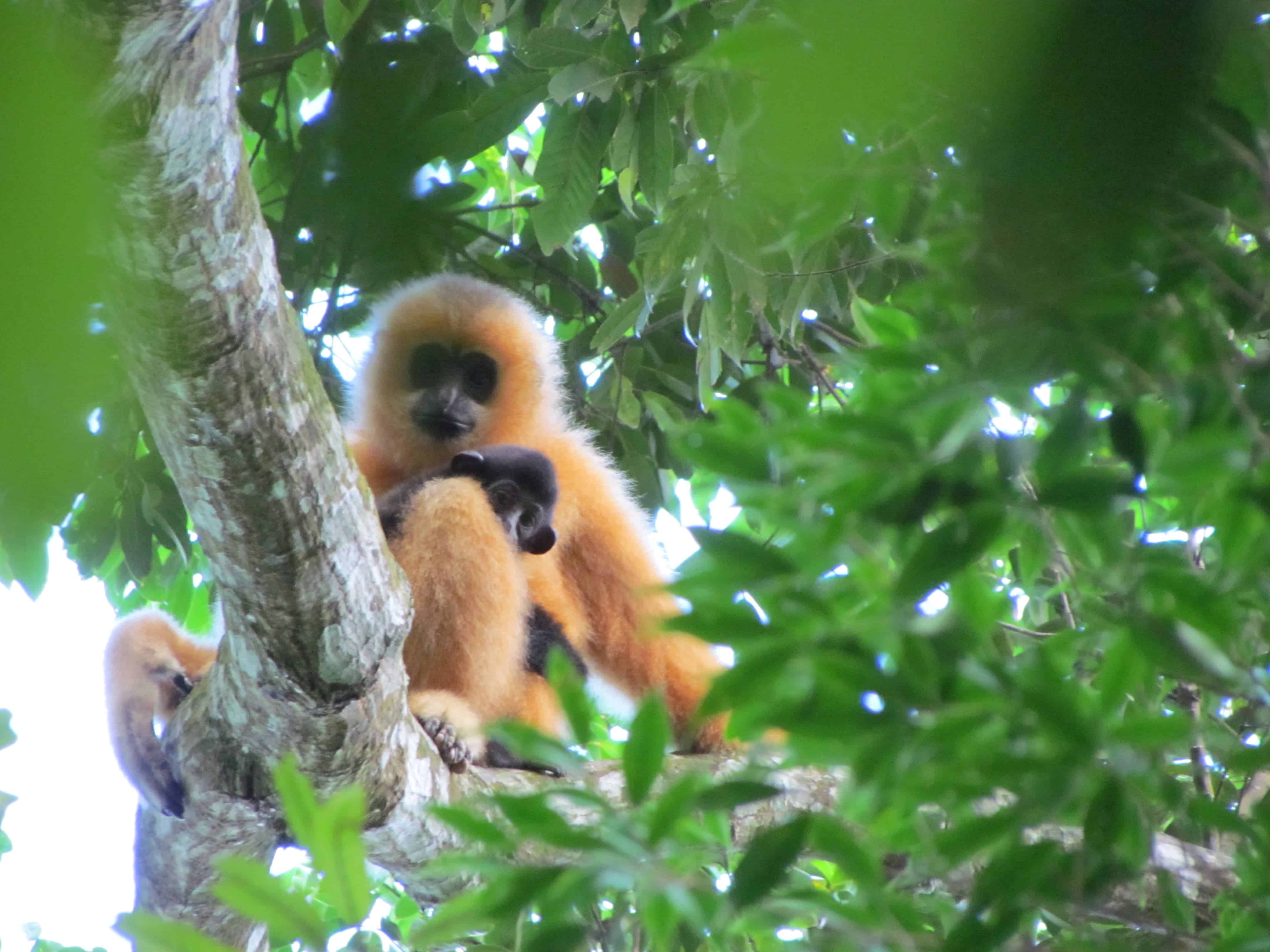
How we got to be here is one of humanity’s most enduring questions. And it comes in many layers: first in understanding how the Universe formed, then how life appeared on Earth, and how we, humans, specifically came to be. We have a pretty good handle on where and how humans evolved, but there’s a side quest that has been alluding scientists since the first glimmers of philosophy: the origin of human consciousness.
Suffice it to say, we still don’t know how exactly we’ve been granted this extraordinary gift. We may never know for sure. But as always, we have some theories. Some have attributed this great leap in cognitive development to the use of tools, while others point to the development of language. And one of the more creative origin hypotheses involves drugs.
This theory, known as the “Stoned Ape Theory,” suggests that the key to understanding the evolution of human consciousness may lie in the consumption of psychedelics.
The theory, first proposed by Terence McKenna in the 1990s, suggests that the use of psychedelics played a crucial role in the evolution of early human ancestors. According to McKenna, the consumption of psychedelics, particularly psilocybin mushrooms, allowed our ancestors to develop advanced cognitive abilities, such as language and abstract thinking.
The theory is based on the idea that early human ancestors, living in African savannas around 2 million years ago, began consuming psilocybin mushrooms that grew on the dung of grazing animals. These mushrooms, which contain the psychoactive compound psilocybin, would have had a profound effect on the brain, leading to increased neural plasticity and the development of new cognitive abilities.
As wild as it may sound, there are actually some merits to this idea. On the flipside, critics highlight the fact that the Stone Ape Theory is pure speculation.
So, are we the grandchildren of junkie apes? Let’s see what the theory is all about.
Where the Stone Ape Theory came from

First off, let’s get our vocabularies straight here. While known colloquially known as the Stoned Ape Theory, this is not a theory — it is a hypothesis. In science-speak, theories are ideas that have been repeatedly proven true and which have verifiable evidence to back them up. For example, we have a theory that evolution is a thing and it works over subsequent generations. McKenna’s idea has not been proven, but there isn’t direct evidence to support it either. This isn’t necessarily to say that it’s wrong. All theories start out as hypotheses. But it does mean that we’re basically discussing some dude’s educated guess and not facts.
The theory has its roots in the book Food Of The Gods: The Search for the Original Tree of Knowledge, published by Terrence McKenna in 1992. McKenna was an American ethnobotanist, a branch of science that studies how different cultures or groups of people traditionally employed plants in their environment for medical, cultural, or other purposes. It’s a field that has given us the means to develop drugs and other useful compounds or processes in the past. He also did quite a lot of academic work on the origins of shamanism which is still cited to this day.
McKenna was also a self-proclaimed mystic and a supporter of the use of naturally-occurring psychedelic plants. I don’t personally believe in the practical applications of mysticism — I don’t think a crystal healer will quartz your cancer away. But I can understand how someone whose job is to interact with traditional healers such as shamans can gain an affinity for it. After all, these roles maintained themselves throughout the centuries via the very strong, very transformative experiences they can offer. As a means of self-discovery or perhaps in support of mental health or subjective well-being, such experiences can hold value. He’s also the originator of the “novelty theory“, a concept about the nature of time based on fractal patterns McKenna claimed to have discovered in the I Ching.
I start with a description of the man himself because it’s important to note that he did achieve academic success and recognition in, perhaps, the same measure as he gained popularity for some pseudoscientific ideas. Now, a man’s character isn’t a reflection of his ability to be right or wrong — even a broken clock is right two times a day, and wrong the rest of the time. But McKenna is interesting, particularly because of this juxtaposition between the provable and improbable in his work.
Ok so now let’s get to the meat and potatoes of this topic.
Mushroom dinner

The Stoned Ape Theory basically states that psychedelic mushrooms were the catalyst that helped our species arise from ancient hominids. In short, it says that psilocybin, the main active compound in ‘shrooms, altered the behavior of Homo erectus, which first evolved two million years ago, in ways that set them on an evolutionary path towards us, modern humans.
The long version is that, during the desertification of Africa (an event we know happened), our very ancient ancestors were forced to leave their traditional home — the canopy roofs sprawling across the continent. The increasingly dry climate meant that forests were dwindling, both in density and geographical spread, and could no longer support these populations; so they had to move in search of food.
At first, they lived as gatherers and scavengers, learning their way through the new, treeless environment they were thrust into — the savannah. Around the year 100,000 BCE, McKenna argues, Homo erectus came into contact with the mushroom Psilocybe cubensis and incorporated it into their diet. According to McKenna, insects were likely an important source of protein for these hominids, as they’re much easier to catch compared to other prey.
In the savannah, cow dung can serve as an important source of food for insects, so they tend to be attracted to them. P. cubensis also loves manure — it tends to grow in it. This would be the link tying Homo erectus to psilocybin; as they scavenged for insects, they saw these tasty-looking mushrooms, so they started eating those, too.
Ape together stoned
Sustained intake of psilocybin, in McKenna’s theory, set our hominid ancestors on a path toward success. He explains that low levels of psilocybin improve vision clarity, making it easier to pick out edges and contours, specifically. This, he argues, would make the individuals who did eat the mushrooms better hunters, which would, in turn, give them an evolutionary edge over those who didn’t. More available food meant they had a higher social standing and better reproductive success.
Slightly higher doses would also help, he contends, as they lead to an increase in libido, higher levels of energy, and could potentially cause erections in males, promoting the proliferation of more offspring for those who consumed the mushrooms.
At yet higher doses still, McKenna adds, psilocybin would promote a sense of community, and maybe even group sex, by “dissolving boundaries” between group members. In an age well before paternity tests, he goes on to argue, this would lead to a greater sense of community as everyone was taking care of all the offspring as if they were their own. It would also promote genetic diversity, for obvious reasons. These higher doses would also promote the development of language and higher brain functions through the visions and other psychedelic effects they produce. Religion might also have been jump-started by this substance, due to its effects on our subjective perception of the ego.
Some time between two million and 700,000 years ago, the brain size of Homo erectus effectively doubled. That’s a blink of an eye on an evolutionary timeline and McKenna has often argued that this leap in brain power could be attributed to the mind-enhancing effects of psychedelic substances found in nature.
The TL;DR of it all is that, in McKenna’s theory, our ancestors ate psychedelic mushrooms which made their brains go into overdrive. This, in turn, led to the creation of art, religion, speech, and all the other traits that set us apart from the animal world.
Did they, really?

There is definitely an allure behind the Stoned Ape Theory; it’s a good story, and we like good stories. I think it’s a good, interesting story, at least. It also probably makes for a good point of conversation for college freshmen and other people the world over as they’re experimenting with their own psychedelics — which can’t but help. But is it true?
The main issue leveled at this hypothesis is that McKenna builds a series of assumptions on very shaky feet. Then he uses these assumptions as a starting point for other assumptions, similarly unsupported. For example, the whole of McKenna’s hypothesis relies on our ancestors finding and eating a certain mushroom, Psilocybe cubensis, in manure along the savannah. But P. cubensis is a species that favors hot and humid areas; savannahs are hot, but not humid. Still, we could probably substitute it for its relative species. P. azurescens, P. cyanescens, and P. allenii, for example, tend to favor the drier, Mediterranean climates.
In short, this example shows how McKenna tends to take bits of data that aren’t really proven to be true and kinda just roll with them. I’ll reiterate that this doesn’t mean his hypothesis can’t be true, but these arguments don’t go a long way to helping prove that it is true, either. And he keeps doing this, over and over, with his Stoned Ape Theory. In other words, the entire hypothesis is unprovable.
McKenna cites previous work to support his argument that psilocybin consumption increases visual acuity, but that paper didn’t find that such a compound actually makes you see more clearly. The paper reports that psilocybin changes visual perception, not that it makes it better or clearer. In fact, the authors explain that even at such low doses, the changes caused by the compound “may not be conducive to the survival of the organism” — which goes completely against McKenna’s conclusion that eating shrooms made early hominids better hunters.
It keeps going on like this. His idea that hallucinations prompted religion and speech, is again, not propped up by evidence, but an assumption. The idea that eating the mushrooms made males horny, even if true, doesn’t mean that it made them more successful in mating. God knows that if all it took was being horny, we’d all be getting laid hard. Hallucinating, also, doesn’t increase your likelihood of having sex.
But perhaps both the biggest critique and appeal of the Stoned Ape Theory is its seductive simplicity. It suggests that some individuals or groups of early humans supercharged their brains and developed consciousness due to some random encounter with magic mushrooms. In reality, complex traits like the hallmarks of human intelligence — symbolic language, complex social networks, and intricate tool use — do not appear overnight. That never happens. They also don’t happen once due to some mutation in a single individual. These are the kind of traits that appear independently across different populations that are geographically separated and are eventually selected to become incorporated into the general population.
There’s also the obvious flaw that people’s dietary history is not inherited. Although exposure to stress and famine can introduce some epigenetic changes that seem inheritable, the dramatic shift required to induce consciousness in primates would have to be etched into our DNA through mutations that are passed down the germline. You can’t pass on the experience of a previous psychedelic trip to your offspring.
I don’t mean to sound like I want to rip into McKenna — I really don’t. Personally, I find his hypothesis fascinating, and definitely worth a few chuckles if proven true. But that’s just the thing: the whole train of thought doesn’t really have evidence to back it up. Is it possible that the Stoned Ape Theory is right? Definitely. Do I want it to be right? Completely. It would just be too delicious an irony that we only developed advanced math and other cutting-edge geekery because our ancestors spent their days tripping their fur off.
But can I, or anyone else, say for sure that it is? No. There’s nothing we know of that would mean it couldn’t happen, although parts of it seem improbable to say the least. But there’s also not enough here to explain reliably how it could happen, despite the fact that overall, it has a certain appeal.
McKenna’s story itself also tends to color how people view this hypothesis. Some will point to his academic success and invoke this as a sign that his work is reliable, which is a logical fallacy. Others point to his more exotic ideas, arguing that these discredit his outlandish hypothesis. I personally see both him and the Stoned Ape Theory as very odd, in the sense that they’re distinct, they stand apart from their peers.
Someone who studies folk uses for plants and shamanism, even academically, must be willing to accept information acquired outside of normal academic processes. The conclusions we draw from this information must and will be tested, of course. But a certain willingness to entertain strange ideas is required in these fields that very often deal with traditions, stories, rituals, and myths told and retold over the centuries — not cold hard figures.
I think it’s possible that McKenna’s areas of interest, his academic work, and his personal experiences with psychedelics opened a more intuitive understanding of the topic — or at least, one that didn’t always fit into the rigorous demands of the scientific method. He may well have been seeing something we’re all missing, and he may have been right. He may also have been wrong. The saddest part of his legacy, I think, is that we’ll likely never know.






